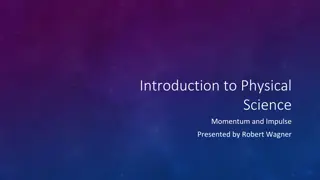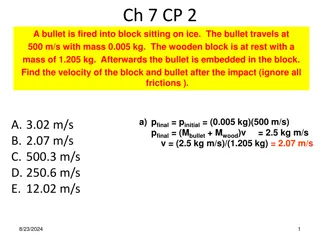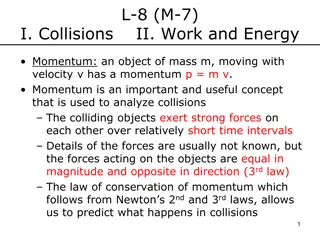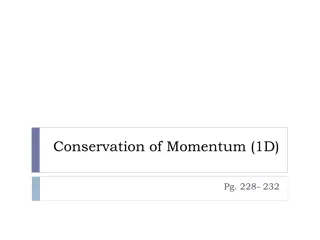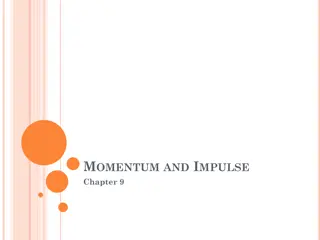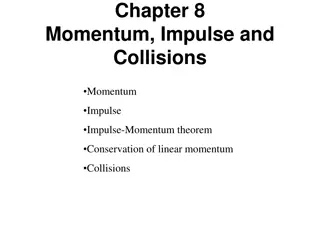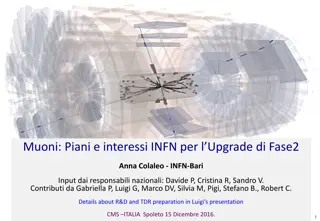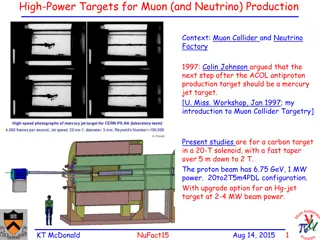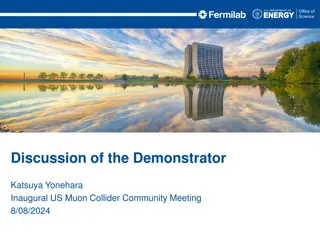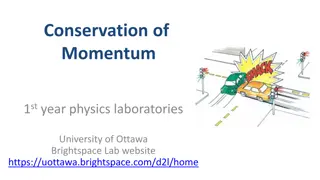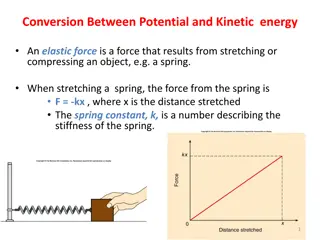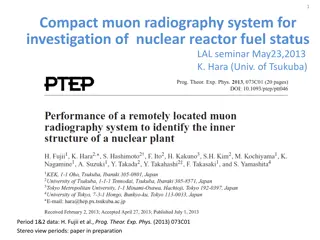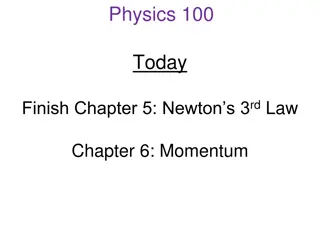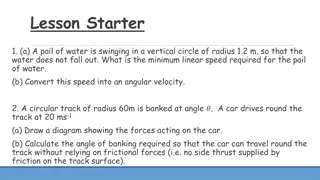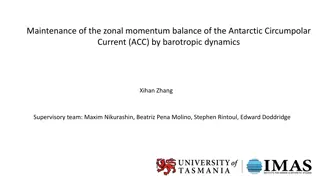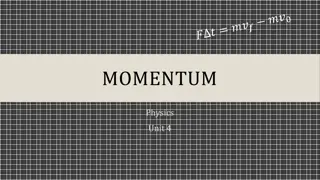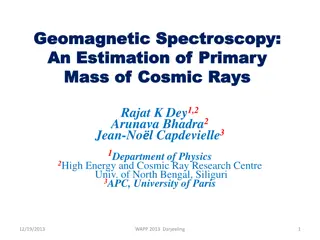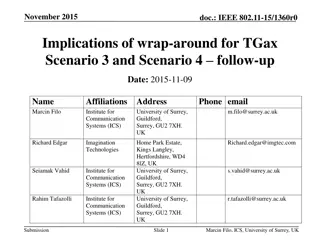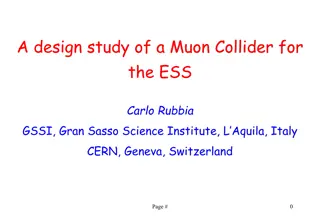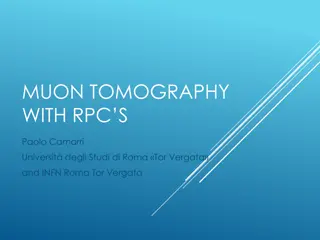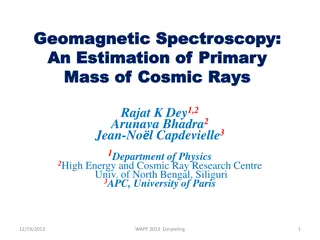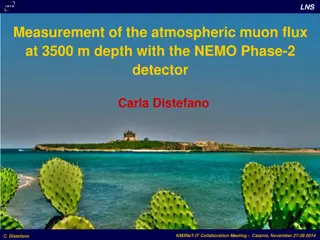Momentum and Impulse in Physical Science
Momentum and impulse play crucial roles in physical science, with momentum defined as mass multiplied by velocity and impulse as the change in momentum. This concept is explored through examples and discussions on Newton's Second Law and practical applications in everyday life, such as airbags in ca
3 views • 8 slides
Angular Mechanics - Angular Momentum Concepts and Examples
Understanding angular momentum in mechanics involves reviewing linear and angular quantities, comparing angular to linear formulas, and exploring examples of angular momentum and conservation principles. The content covers key factors like angular quantities, torque, and moment of inertia, along wit
3 views • 23 slides
Momentum and Impulse in Sports
Momentum and impulse play a crucial role in sports performance. In a volleyball scenario where a ball is hit back by a player, understanding the change in speed, velocity, and force exerted can enhance gameplay strategies. Momentum is a key physics concept that affects an object's motion and the for
1 views • 40 slides
RF Considerations for High-Energy Muon Collider
This work package focuses on assessing feasibility issues and technological challenges of RF systems for a high-energy muon collider. Tasks include defining RF systems for acceleration and cooling complexes, addressing high gradients, beam loading, breakdown mitigation, and optimizing cavity distrib
0 views • 11 slides
Neutron Multiplicity Measurement in Muon Capture on Oxygen in Super-Kamiokande
Explore the neutron multiplicity measurement in muon capture on oxygen using Super-Kamiokande, a water-Cherenkov detector located underground in Japan. Gadolinium was added to enhance neutron tagging efficiency, aiding in Supernova observation, proton decay rejection, and more. Neutron signals are t
0 views • 16 slides
Momentum in Physics
Explore the concept of momentum in physics through scenarios involving collisions and rotational displacement. Learn how momentum is conserved in different situations and its impact on the final direction of motion. Discover the relationship between velocities, masses, and changes in momentum in var
0 views • 31 slides
Momentum and Collisions in Physics
Momentum plays a crucial role in analyzing collisions, where objects exert forces on each other over short time intervals. Conservation of momentum, following Newton's laws, allows predicting outcomes in collisions by redistributing momentum among objects. The concept is illustrated through examples
0 views • 25 slides
Conservation of Momentum in Physics
Conservation of momentum in physics addresses how the total momentum of a system remains constant in a collision or interaction between objects. Newton's Third Law and the law of conservation of momentum play key roles in explaining the transfer of momentum between objects during collisions. Momentu
1 views • 11 slides
Momentum and Impulse in Physics
Explore the concepts of momentum and impulse in physics, including the definition of momentum, the impulse-momentum theorem, and how factors affect object motion post-collision. Discover how momentum plays a vital role in describing an object's motion and learn about the relationship between force,
1 views • 30 slides
Momentum, Impulse, and Collisions in Physics
Learn about momentum, impulse, and collisions in Chapter 8 of physics. Understand how linear momentum, impulse, and the Impulse-Momentum theorem are crucial in analyzing collisions and conservation of momentum. Explore real-world applications in sports and scenarios like a child driving a bumper car
0 views • 19 slides
Muon Phase2 Upgrade: INFN Collaboration for Detector Enhancement
The Muon Phase 2 upgrade project aims to improve the performance of muon detectors for the HL-LHC conditions. Collaborating with INFN, the project focuses on maintaining excellent triggering and measurement capabilities under harsher conditions. Key aspects include existing detector consolidation, n
1 views • 17 slides
Momentum and Collisions Explained Through Illustrations
Explore various scenarios involving momentum, collisions, and elastic interactions through illustrated examples. Understand concepts such as total momentum in different situations, speeds of masses after collisions, momentum conservation in 1-D and 2-D collisions, and changes in momentum direction.
0 views • 28 slides
High-Power Targets for Muon and Neutrino Production
Colin Johnson advocated for a mercury jet target as the next step for muon production post-ACOL. Current studies focus on a carbon target with proton beam parameters optimized for muon generation. Carlo Rubbia discussed a potential Muon-Collider Higgs Factory concept at CERN, sparking debate on muon
0 views • 11 slides
Developments in Muon Collider Technology at the Inaugural US Muon Collider Community Meeting
Discussion at the US Muon Collider Community Meeting highlighted advancements in muon accelerator technology, with a focus on the Demonstrator by Katsuya Yonehara. Key topics included the layout of the muon accelerator complex, achievements in ionization cooling, and the MERcury Intense Target. The
1 views • 14 slides
Insights into Muon Tracking Efficiency in Wire-Cell Research
Explore the evaluation of single muon efficiency through detailed simulations in the Wire-Cell project. Discover advancements in track merging algorithms and the calculation of tracking efficiency using various variables. Dive into the challenges and progress in muon tracking within detector limitat
0 views • 13 slides
Muon Campus Operation Report & Performance Summary
This report provides an overview of the Muon Campus operations, including activities conducted, machine downtime, G-2 performance integrated for Run 4, and upcoming plans. Key highlights include beam delivery to G-2, maintenance work, beamline studies, and the status of experiments. The report also
0 views • 5 slides
Conservation of Momentum in Collisions: University of Ottawa Physics Lab
Study the conservation of linear momentum and energy in elastic and inelastic collisions in one dimension at the University of Ottawa's physics lab. Analyze the motion of gliders on an air track, observe changes in velocity, momentum, and energy, and compare position-time and velocity vs. time graph
0 views • 15 slides
Update on Rock Interaction Events by Palash Kumer Roy
This update discusses the selective retention of GENIE events likely to produce particles reaching the hall, interactions with rockboxes, muon birth rates in TMS, and muon momenta from upstream and downstream rocks. Discrepancies in muon rates are noted, prompting further investigation.
0 views • 14 slides
Energy Conversion, Power, and Momentum in Physics
Exploring the concepts of energy conversion between potential and kinetic energy, the importance of power in work efficiency, and the role of momentum and impulse in describing motion in physics. The discussion covers elastic forces, work done, power calculations, examples of watt and joules, as wel
1 views • 28 slides
Compact Muon Radiography System for Investigation of Nuclear Reactor Fuel Status
A seminar presentation at LAL on May 23, 2013, discussed a compact muon radiography system designed for investigating the status of nuclear reactor fuel. The system, developed by researchers from the University of Tsukuba, involved the use of trackers with scintillators and muon detectors at various
0 views • 56 slides
Momentum and Impulse in Physics
Momentum is the product of an object's mass and velocity, while impulse is the change in momentum resulting from a force acting over time. By applying force for a longer duration, momentum can be increased or decreased effectively. The relationship between impulse and momentum is crucial in understa
0 views • 26 slides
Momentum and Impulse in Physics
Momentum, defined as mass x velocity, and impulse, the change in momentum resulting from a force over time, are essential concepts in physics. This chapter explores how momentum can be altered through changes in mass or velocity and how impulse affects momentum. The relationship between force, time,
0 views • 27 slides
Angular Momentum in Physics
Learn about the concept of angular momentum in physics through practical examples and explanations. Explore how angular momentum is conserved in rotating bodies and how it impacts various sports activities. Discover the relationships between moment of inertia, angular velocity, and conservation of a
1 views • 19 slides
Momentum in Physics
Momentum, first introduced by Isaac Newton, is symbolized by the letter p and signifies inertia in motion. It is calculated as mass multiplied by velocity (p = m * v) and has the unit of kg * m/s. The amount of momentum depends on the object's mass and speed. A moving object has more momentum if eit
1 views • 18 slides
Zonal Momentum Balance in the Antarctic Circumpolar Current
This study investigates the zonal momentum balance of the Antarctic Circumpolar Current (ACC) by analyzing the interplay between wind stress, topographic form stress, and eddy dynamics. The research explores the maintenance and adjustment of momentum balance in the ACC, emphasizing the roles of baro
0 views • 10 slides
MOMENTUM
In this lesson, you will define impulse and linear momentum, explain the relationship between momentum and force, and describe the effects of impulses in everyday life. Understand the significance of force, time of contact, and impulse in hitting a ball effectively. Explore how objects respond to im
0 views • 39 slides
Estimation of Primary Mass of Cosmic Rays Using Geomagnetic Spectroscopy
The study delves into the utilization of geomagnetic effect to estimate the primary mass of cosmic rays. It explores the pronounced geomagnetic effect on muon components and discusses discriminating heavy nuclei and proton induced showers through various factors such as the ellipticity of lateral mu
0 views • 21 slides
MOMENTUM
Momentum is a crucial concept in physics, defined as the product of an object's mass and velocity. Learn about when an object has momentum, how it relates to inertia and motion, and how impulse can change momentum. Explore scenarios comparing momentum between objects of different masses and velociti
0 views • 30 slides
Muon Reconstruction Performance in Run II by CMS Collaboration
Insights into muon reconstruction performance during Run II by the CMS Collaboration using tag-and-probe method for efficiency calculations and Z+ events for resolution inference. Details include muon identification, methods, tag-and-probe parameters, and resolution measurements.
0 views • 11 slides
Conservation of Momentum in Collisions
Investigate the conservation of momentum through quantitative experiments using a motion sensor. Explore the relationship between momentum, mass, and velocity in collisions, whether elastic or inelastic. Understand the theoretical background behind the principle of momentum conservation and its appl
0 views • 24 slides
Intense Muon Beams for Higgs Studies at ESS SB Project
The ESS SB project focuses on intense muon beams for studying the Higgs-related scalar sector. Key components include production, accumulation, cooling, and collider rings for Higgs studies. With a practical Higgs factory in mind, the facility features high-intensity H-source, p-compressor rings, io
0 views • 19 slides
Intense Muon Beams for Higgs Studies at ESS SB Project
The ESS SB project aims to create an intense muon beam facility for studying the Higgs sector. It involves muon production, cooling, and acceleration to enable Higgs studies. The project includes a high-intensity H-source, compression rings, ionization cooling system, LINAC acceleration, and collide
0 views • 8 slides
Momentum Concept iClicker Questions
Explore momentum concepts through iClicker questions related to kinetic energy, momentum of systems, and the relationship between momentum and kinetic energy in systems of particles. Understand the implications of zero kinetic energy and momentum in different scenarios.
1 views • 53 slides
muon acceptance
The Muon Acceptance in the KLOE Experiment is enhanced by a new straw tube module configuration with a compact radiator, higher density in the tracking region, and additional trackers utilizing the magnetic field. Various muon momentum spectrums and hits in different detectors at different momenta a
0 views • 18 slides
Muon Collider Design Study for ESS at GSSI and CERN
Explore the design study of a Muon Collider for the ESS carried out by Carlo Rubbia at GSSI, Italy, and CERN, Switzerland. The study delves into muon beams, proton beams, muon cooling, and the main steps of the process. Discover the potential advancements in the Higgs sector and the innovative techn
0 views • 6 slides
Muon Tomography with RPC: Features, Implications, and Design
Explore the world of Muon Tomography with Resistive Plate Chambers (RPCs) as discussed by Paolo Camarri from Universit degli Studi di Roma Tor Vergata and INFN Roma Tor Vergata. Discover the general features of RPCs, space resolution achievable, implications of atmospheric muon flux, and the design
0 views • 12 slides
Estimation of Primary Cosmic Ray Mass Using Geomagnetic Spectroscopy
Explore how the geomagnetic effect can be used to estimate the primary mass of cosmic rays. This study focuses on the pronounced impact of geomagnetic effects on muon components and its potential for discriminating between heavy nuclei and proton-induced showers through various parameters like muon
0 views • 21 slides
Atmospheric Muon Flux Measurement at 3500m Depth with NEMO Phase-2 Detector
Explore the atmospheric muon flux measurement at 3500m depth using the NEMO Phase-2 detector discussed at the KM3NeT-IT Collaboration Meeting. The data includes details on muon triggers, live time, accumulated events, and post-trigger data analysis.
0 views • 17 slides
Understanding Impulse and Momentum in Physics
Learn about impulse, linear momentum, and the relationship between force and momentum in everyday scenarios. Explore how time of force application impacts object response and delve into the concept of impulse as a change in momentum. Discover the importance of momentum in collisions and how to calcu
0 views • 46 slides
Muon Calibration: A Brief Introduction for CTA Telescopes
Explore the feasibility study on using muon rings to calibrate the total optical throughput of Cherenkov Telescope Array (CTA) telescopes, assessing viability, precision estimates, monitoring strategies, and calibration methods. Learn about the potential of muon ring analysis as the principal calibr
0 views • 18 slides
